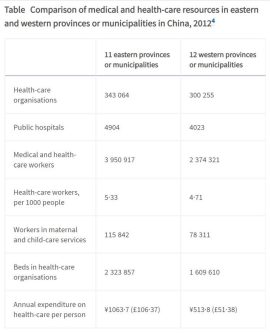Supervised by: Fidelia Hein, BSc. Fidelia holds a Bachelor of Science in International Business from Reutlingen University. She is currently completing her MBA degree at the University of Oxford Saïd Business School. Prior to starting her MBA degree, Fidelia was a business manager at the multinational corporation Olympus Surgical Technologies Europe.
COVID-19 is a contagious disease caused by the newly discovered coronavirus. The first case was identified in Wuhan, China, in December 2019; the virus then spread worldwide. Inequality is the unequal distribution of resources in a society, and this phenomenon exists in many areas, like access to food and healthcare. These are mostly caused by different wealth conditions between people or even between countries. With China’s reform and opening up in 1978, China’s economic growth rate is unprecedented, but the problem that comes with this booming growth is the increase in inequality in China’s society. In the COVID-19 pandemic, whether it has deepened or reduced, the situation of inequalities has somehow changed. The impacts of the pandemic are not just on inequality within a country; it also has a significant impact on economies around the world, in both the short term and the long term.

Figure 1 (Wang and Zeng, 2015)
The inequalities in access to healthcare existed before the COVID-19 pandemic in China. In 1978, when China reformed and opened, serious inequalities had existed in healthcare provision between eastern and western provinces, and urban and rural areas for some time in the country. The Chinese Government has attempted to address the problem of inequality in healthcare and, in 2004, a major government initiative—The Myriad Doctors Supporting Rural Health Care Project—involving large hospitals in the urban eastern provinces was launched, to provide support for hospitals in rural western provinces through long-term exchange programmes (Wang and Zeng, 2015). We can see there is a significant difference in the annual health expenditure per person in eastern provinces versus western provinces. This is because of the different growth speeds in western provinces and eastern provinces; as eastern provinces are mostly coastal, they have the geographical advantage for trade, which leads to a higher speed of development in eastern provinces and means the average disposable income in eastern provinces is higher than western provinces, so people can spend more money on healthcare. This also means that the eastern provincial governments have more funds to be invested in education and healthcare, which leads to better medical conditions.
In the COVID-19 pandemic, the inequality in access to healthcare in China has changed; because of the policies made by the Chinese Government, the inequalities in healthcare have reduced to a certain extent. At the start of 2020, when the epidemic in Wuhan started to break out, the number of available beds in hospitals in Wuhan were beginning to be exceeded by demand, which meant some people who had coronavirus symptoms could not be admitted to the hospital, so Wuhan’s government decided to build two hospitals to treat patients with COVID-19. On 24 January 2020, the design of the first hospital was completed and construction started – they named it Huoshenshan Hospital – and on 2 February 2020, the construction was completed. The hospital began to take patients on 4 February 2020. Construction at the second hospital, Leishenshan Hospital, finished on 5 February 2020. The Huoshenshan Hospital has 1000 beds and the Leishenshan Hospital has 1600 beds, making a total of 2600 new beds, which reduced the pressure on existing hospitals. After that, the Wuhan government also used the Wuhan Sports Center Stadium as a module hospital to treat patients with milder symptoms. There are 13 module hospitals in Wuhan in total, ensuring that every patient can have a bed and be treated. The most important factor in equality of care is that the costs of treatment and the costs of vaccinations are reimbursed by the government, meaning everyone who has medical insurance and gets COVID-19 has free treatment available. This reduces the issue of wealth in healthcare inequalities.
The COVID-19 pandemic did not just impact inequalities in healthcare; it also affected economies around the world. In the short term, the impact on the economy is the direct and indirect spending of the government and the slow down in growth rates due to all the restrictions of the pandemic. The Ministry of Finance of China stated that, by July 2020, China had arranged RMB66.53 billion for an epidemic prevention and control fund, plus an estimated RMB4.9 trillion (or 4.7 percent of GDP) of discretionary fiscal measures were announced, of which RMB4.2 trillion is estimated to have been implemented in 2020. These funds have been spent on:
- Epidemic control and prevention
- Producing necessary medical equipment
- Unemployment insurance and subsistence allowance
- Tax relief
- Public investment
This increase in public spending will be hoped to prompt the growth of economies; the annual growth of the GDP in all the Major Advanced Economies (Canada, France, Germany, Italy, Japan, UK, US) was negative in 2020. Of the Selected Emerging Economies (Brazil, China, India, Russia, Saudi Arabia and South Africa), only China had positive growth of approximately 2% (Real GDP Growth, 2021). The UNCTAD report pointed out that in 2020, due to the pandemic’s impact, the global trade in goods fell 5.6% year-on-year, which was the largest year-on-year decline in goods trade since the 2008 financial crisis. Compared with the trade in goods, trade in services has been hit harder by the pandemic; the trade volume has seen a year-on-year decrease of 15.4%, which is the largest drop since 1990.
The pandemic also has long term economic impacts, such as a loss of income and labour force due to the number of fatalities. Prager, Wei and Rose (2016) estimated that economic losses from an influenza pandemic in the USA would be USD90–220 billion, and of that, 80% would come from the value of expected future lifetime earnings of those who would die. The situation today has some commonalities with the Spanish flu back in 1918; both the flu and COVID-19 can infect anyone, the British Prime Minister David Lloyd George had the flu and the British Prime Minister today, Boris Johnson, had COVID-19. There was also a baby boom in the 1920s, which has often been put down to the war and the men returning from the front, but there is an argument that the flu could have contributed because it left behind a smaller, healthier population that was able to reproduce in higher numbers (Whiting, 2021). There is expected to be a baby boom in 2021, too, due to the restrictions making everyone stay at home. This could have a positive long term effect, as the population can increase and, as governments are investing in education, the quantity and quality of factors of production are likely to increase, which means that economies around the world will possibly have better growth in the next twenty to forty years.
To conclude, the inequalities in access to healthcare in Chinese society before the COVID-19 pandemic broke out were due to the unequal speed of development between the western and eastern provinces; the eastern provinces have better wealth conditions as they have a better geographical location for trade, so people in eastern provinces could have more money to spend on healthcare, and doctors are more willing to work in the eastern provinces. Together, these factors lead to better medical resources concentrated in the more developed cities in the east. After the COVID-19 epidemic broke out in China, the government spent more than RMB100 billion to ensure that every patient could have a hospital bed. This had the effect of limiting the impact of different wealth conditions among people, which reduced the inequalities to an extent. The short term impact of the COVID-19 pandemic is the rapid increase in government spending. By July 2020, China had spent over RMB1.847 billion just on medical expenses, and the spending on epidemic prevention and control was RMB66.53 billion. The long term impact is the loss of income and productivity from people who died in the epidemic, however a baby boom is expected due to the lockdown and restriction of mobility when the epidemic started to break out in China, which may be able to offset the loss of productivity.
Bibliography
- Wang, T. and Zeng, R., 2015. Addressing inequalities in China’s health service. The Lancet, 386(10002), p.1441.
- International Monetary Fund. 2021. [online] Available at: <https://www.imf.org/en/Topics/imf-and-covid19/Policy-Responses-to-COVID 19> [Accessed 22 July 2021].
- International Monetary Fund. 2021. real GDP growth. [online] Available at: <https://www.imf.org/external/datamapper/NGDP_RPCH@WEO/OEMDC/ADV EC/WEOWORLD/GRL> [Accessed 16 July 2021].
- Whiting, K., 2021. A science journalist explains how the Spanish flu changed the world. [online] World Economic Forum. Available at: <https://www.weforum.org/agenda/2020/04/covid-19-how-spanish-flu-changed world/> [Accessed 22 July 2021].




